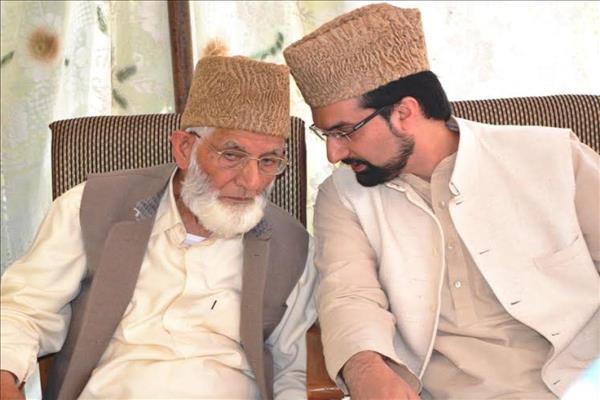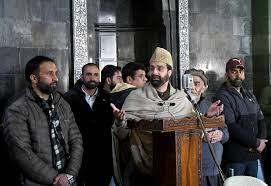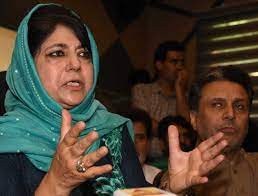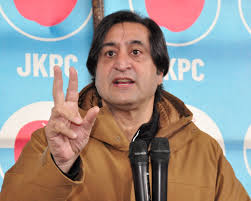The Hurriyat Conference, the political platform of separatists in Kashmir, is getting increasingly marginalised, with the Centre cracking down on its leaders and considering a ban on both factions.
By -Bashaarat Masood
After banning the Jamat-e-Islami and the Jammu and Kashmir Liberation Front (JKLF), there have been reports that the Centre is considering a ban on both factions of the All Parties Hurriyat Conference. What does the Hurriyat Conference stand for, and what is its relevance?
The beginnings
In the winter of 1992, when militancy was at its peak in Kashmir, the separatists felt the need for a political platform that would complement the militant movement and seek a resolution of the Kashmir issue. This led to the formation of the All Parties Hurriyat Conference (APHC), an amalgam of separatist political outfits.
On July 31, 1993, several separatist political, social and religious parties — with disparate ideologies but united by a common view that Kashmir is under “illegal occupation” — stitched together the alliance after seven months of deliberation.
The idea was first discussed on December 27, 1992, at a meeting called by Mirwaiz Umar Farooq, then 19, who had taken over as Kashmir’s head priest (Mirwaiz) and the chairman of Awami Action Committee after the assassination of his father Mirwaiz Mohammad Farooq on May 21, 1990. When the alliance took shape, Mirwaiz was its first chairman.
The Hurriyat’s constitution describes it as a union of political, social and religious parties of J&K, to wage a “peaceful struggle” for resolution of the Kashmir dispute, according to UN resolutions or through tripartite talks – among India, Pakistan and the people of Kashmir.
The Hurriyat essentially was an extension of a poll alliance formed six years earlier. In the 1987 Assembly elections, several social, religious and political parties had joined hands under the banner of the Muslim United Front (MUF) to oppose the National Conference-Congress combine. The elections, widely seen as rigged, sowed the seeds of a civilian and militant movement against what was perceived as New Delhi’s rule in Kashmir.
The structure
The Hurriyat had a two-tier structure: an executive council of seven members, and a general council of close to two dozen members. The Hurriyat constitution didn’t allow any change in the executive council but permitted increasing or decreasing the numbers in the general council.
The executive council was represented by Jamat-e-Islami, a socio-religious outfit that supported Kashmir’s integration with Pakistan; Jammu and Kashmir Liberation Front, a pro-Independence militant outfit that declared a unilateral ceasefire in 1994 to work for a peaceful solution; People’s Conference, a political party founded by Abdul Gani Lone who was assassinated by militants in 2002; Mirwaiz Umar Farooq’s Awami Action Committee; Ittehadul Muslimeen of Shia cleric Abbas Ansari; People’s League led by Sheikh Abdul Aziz who was killed when police fired on protestors marching towards Muzaffarabad in 2008; and Muslim Conference of Prof Abdul Gani Bhat, a professor who was terminated from service by the J&K government for “constituting a threat to the security of the state”.
The general council included trade bodies, students’ associations, and social and religious groups. Its numbers kept changing.
The split
From 1993 until 1996, the Hurriyat was the dominant political force in Kashmir with mainstream political leaders having withdrawn. While the National Conference returned to the political scene during the 1996 Assembly elections, the Hurriyat stayed afloat with backing from Pakistan.
After over a decade, the alliance started crumbling within, struggling to keep its flock together with its disparate ideologies, from moderates like Mirwaiz Umar Farooq and Abdul Gani Lone to hardliners like Syed Ali Geelani and Masarat Alam. Their differences over future strategy, the role of militancy, and dialogue with New Delhi were out in the open.
The 2002 Assembly elections led to a split. The hardline group led by Syed Ali Shah Geelani accused Sajad Lone, representing the People’s Conference after his father’s assassination, of fielding proxy candidates in the elections. The Geelani group demanded Lone’s expulsion, but then Hurriyat chairman Abbas Ansari refused. In a meeting at Geelani’s home on September 7, 2003, the hardliners removed Ansari as Hurriyat chief and announced Masarat Alam as interim chairman. The Hurriyat split into Mirwaiz and Geelani camps.
The J&K Liberation Front led by Yasin Malik parted ways with both factions.
Moderates-Centre talks
The Mirwaiz camp was in favour of dialogue with New Delhi while the Geelani group set a precondition that New Delhi first accepts Kashmir as a disputed territory.
Immediately after the split, the Mirwaiz group opened the channels of dialogue with the Centre. On January 22, 2004, then Deputy PM L K Advani hosted a Hurriyat delegation — Abbas Ansari, Mirwaiz Umar Farooq, Abdul Gani Bhat, Bilal Lone and Fazal Haq Qureshi — at his office in North Block. Both sides decided to meet again. The second round was held in New Delhi on March 27 that year.
Talks continued with the subsequent government. On September 6, 2005, then Prime Minister Manmohan Singh met with Hurriyat moderates led by Mirwaiz. The next round was on May 4, 2006, and the two sides agreed to evolve a mechanism to continue the dialogue for resolution of the Kashmir issue.
With the Centre’s backing, the Mirwaiz faction and Mohd Yasin Malik also travelled to Pakistan on the Srinagar-Muzaffarabad bus to meet the leadership in Pakistan.
The rise of Geelani
The moderates’ perceived closeness to New Delhi and the absence of any outcome from the dialogue bolstered the Geelani-led hardliners. On April 12, 2016, six leaders including Shabir Ahmad Shah, Nayeem Ahmad Khan and Aga Hassan Budgami parted ways with Mirwaiz and joined Geelani.
The current disarray
The National Investigation Agency (NIA) raids on Hurriyat leaders in 2018 put both factions on the backfoot.
On June 30 last year, Geelani sprang a surprise when he dissociated himself from his faction of the Hurriyat, leaving the reins to his deputy Mohammad Ashraf Sehrai who died in custody in Jammu jail earlier this year.
The NIA raids, the ban of Jamat-e-Islami, and the arrest of most of the top and second-rung leadership of both factions, before the abrogation of J&K’s special status on August 5, 2019, have left the Hurriyat in disarray.






